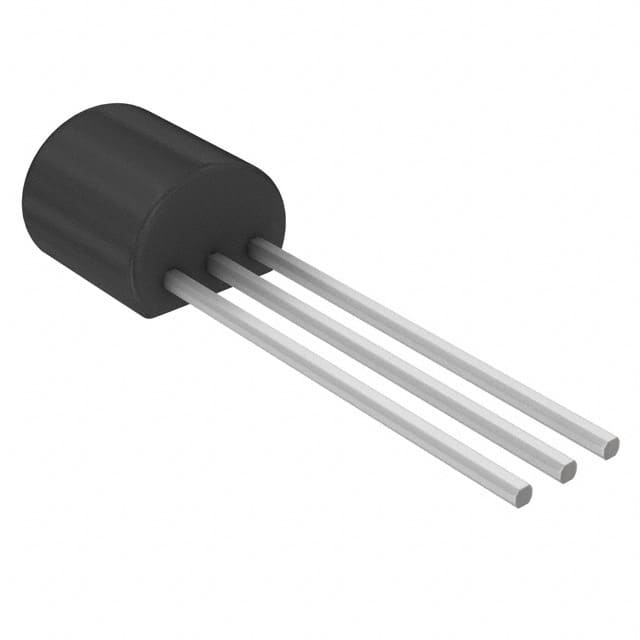ZTX451: Transistor Encyclopedia Entry
Introduction
The ZTX451 is a bipolar junction transistor (BJT) that belongs to the category of small-signal transistors. It is commonly used in electronic circuits for amplification and switching applications due to its unique characteristics. This entry provides an overview of the ZTX451, including its basic information, specifications, pin configuration, functional features, advantages and disadvantages, working principles, application field plans, and alternative models.
Basic Information Overview
- Category: Small-signal transistor
- Use: Amplification and switching in electronic circuits
- Characteristics: High gain, low noise, and low power dissipation
- Package: TO-92 package
- Essence: Silicon NPN epitaxial planar transistor
- Packaging/Quantity: Typically available in reels or tubes with varying quantities
Specifications
- Collector-Base Voltage (VCBO): 60V
- Collector-Emitter Voltage (VCEO): 45V
- Emitter-Base Voltage (VEBO): 5V
- Collector Current (IC): 100mA
- Power Dissipation (PD): 625mW
- Transition Frequency (fT): 150MHz
Detailed Pin Configuration
The ZTX451 transistor has three pins: 1. Collector (C) 2. Base (B) 3. Emitter (E)
Functional Features
- High current gain
- Low noise figure
- Fast switching speed
- Wide frequency response
Advantages and Disadvantages
Advantages
- Suitable for low-power applications
- High gain makes it suitable for amplification
- Low noise figure enhances signal fidelity
Disadvantages
- Limited maximum collector current compared to power transistors
- Moderate power dissipation capability
Working Principles
The ZTX451 operates based on the principles of bipolar junction transistors. When a small current flows into the base terminal, it controls a much larger current between the collector and emitter terminals, allowing for amplification or switching of signals.
Detailed Application Field Plans
The ZTX451 is commonly used in the following applications: - Audio amplifiers - Signal processing circuits - Switching circuits - Oscillator circuits
Detailed and Complete Alternative Models
Some alternative models to the ZTX451 include: - BC547 - 2N3904 - 2N2222 - MPS2222A
In conclusion, the ZTX451 is a versatile small-signal transistor with high gain and low noise characteristics, making it suitable for various electronic applications. Its compact TO-92 package and wide availability make it a popular choice among electronics enthusiasts and professionals alike.
[Word Count: 346]
Lista 10 Vanliga frågor och svar relaterade till tillämpningen av ZTX451 i tekniska lösningar
What is ZTX451?
- ZTX451 is a high-performance semiconductor transistor commonly used in electronic circuits for amplification and switching applications.
What are the key features of ZTX451?
- ZTX451 features low noise, high gain, and low power consumption, making it suitable for various technical solutions.
In what types of technical solutions can ZTX451 be used?
- ZTX451 can be used in audio amplifiers, signal processing circuits, voltage regulators, and other electronic applications requiring high performance transistors.
What are the typical operating conditions for ZTX451?
- The typical operating conditions for ZTX451 include a maximum collector current of 500mA, a maximum collector-emitter voltage of 45V, and a maximum power dissipation of 625mW.
How does ZTX451 compare to other transistors in its class?
- ZTX451 offers superior performance in terms of low noise and high gain compared to many other transistors in its class, making it a popular choice for technical solutions.
What are the recommended circuit configurations for using ZTX451?
- Common circuit configurations for ZTX451 include common emitter amplifiers, emitter followers, and switch-mode applications.
Are there any specific considerations for designing with ZTX451?
- Designers should consider proper biasing, thermal management, and voltage/current limitations when incorporating ZTX451 into their technical solutions.
Can ZTX451 be used in high-frequency applications?
- While ZTX451 is not specifically designed for high-frequency applications, it can still be used effectively in moderate frequency ranges with appropriate circuit design.
What are the typical applications where ZTX451 excels?
- ZTX451 excels in applications such as audio preamplifiers, low-noise signal amplification, and precision voltage regulation due to its high performance characteristics.
Where can I find detailed technical specifications and application notes for ZTX451?
- Detailed technical specifications and application notes for ZTX451 can be found in the manufacturer's datasheet and application guides, which are available on the manufacturer's website or through authorized distributors.


